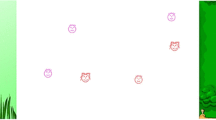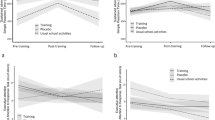Abstract
Few studies have examined whether attention can be improved with training, even though attention difficulties adversely affect academic achievement. The present study was a randomized-controlled trial evaluating the impact of Computerized Attention Training (CAT) and Computer Assisted Instruction (CAI) on attention and academic performance in 77 inattentive first graders. Students receiving either intervention were more likely than controls to show a moderate decline in teacher rated attention problems in first grade. Students receiving CAI also showed gains in reading fluency and in teacher ratings of academic performance. Intervention effects for attention were absent by second grade largely because attention problems declined in all groups. However, post hoc analyses indicated potential longer-term benefits for children with 6 or more inattentive symptoms at baseline. Persistent attention problems were associated with poorer academic performance in multiple domains. Results provide initial evidence that CAT and CAI can improve children’s attention in the classroom - and support additional studies to determine whether more clinically significant benefits are attainable.
Similar content being viewed by others
References
Barkley, R. (2007). School interventions for attention deficit hyperactivity disorder: where to from here? School Psychology Review, 36, 279–286.
Barkley, R., Fischer, M., Smallish, L., & Fletcher, K. (2006). Young adult outcome of hyperactive children: Adaptive functioning in major life activities. Journal of the American Academy of Child & Adolescent Psychiatry, 45, 192–202.
Bellucci, D. M., Glaberman, K., & Haslam, N. (2003). The effectiveness of computer-assisted cognitive rehabilitation for patients with chronic mental illness. Schizophrenia Research, 59, 225–232.
Cantwell, D. P., & Baker, L. (1991). Association between attention-deficit/hyperactivity disorder and learning disorders. Journal of Learning Disabilities, 24, 88–95.
Clarfield, J., & Stoner, G. (2005). Research brief: The effects of computerized reading instruction on the academic performance of students identified with ADHD. School Psychology Review, 34, 246–254.
Conners, C. K. (1997). Conners’ rating scales-revised. North Tonawanda, NY: Multi-health systems.
De Long-Cotty & Levenson, T. (2004). The impact of destination reading: summary of research findings. Retrieved September 3, 2005, from the WestEd web site: http://hmlt.hmco.com/downloads/Research/
Din, F. (1996). Computer-assisted instruction, students’ off-task behavior and their achievement. Education and Treatment of Children, 19(2), 170–183.
Dittman, C. (2008). An investigation of the concurrent and predictive contribution of ADHD- like behaviours and phonological processing to early word reading development. Unpublished doctoral dissertation. Queensland, Australia: The University of Queensland.
DuPaul, G. J. (2007). School-based interventions for students with attention deficit hyperactivity disorder: current status and future directions. School Psychology Review, 36, 183–194.
DuPaul, G. J., & Eckert, T. L. (1998). Academic interventions for students with attention- deficit/hyperactivity disorder: a review of the literature. Reading & Writing Quarterly, 14, 59–73.
DuPaul, G. J., Rapport, M. D., & Perriello, L. M. (1991). Teacher ratings of academic skills: the development of the Academic Performance Rating Scale. School Psychology Review, 20, 284–300.
DuPaul, G. J., Stoner, G., & O’Reilly, M. J. (2002). Best practices in classroom interventions for attention problems. In A. Thomas & J. Grimes (Eds.), Best practices in school psychology, vol. 2 (pp. 1115–1127). Washington, DC: National Association of School Psychologists.
Good, R., Gruba, J., & Kaminski, R. (2002). Best practices in using dynamic indicators of basic early literacy skills (DIBELS) in an outcomes-driven model. Best practices in school psychology IV (Vol. 1, Vol. 2) (pp. 699–720). Washington, DC: National Association of School Psychologists.
Hintze, J. M., Ryan, A. L., & Stoner, G. (2003). Concurrent validity and diagnostic accuracy of the dynamic indicators of basic early literacy skills and the comprehensive test of phonological processing. School Psychology Review, 32, 541–556.
Kaufman, A. S., & Kaufman, N. L. (2004). Kaufman brief intelligence test, 2nd edn (KBIT-2). Circle Pines, MN: American Guidance Service Publishing.
Kerns, K. A., Eso, K., & Thomson, J. (1999). Investigation of a direct intervention for improving attention in young children with ADHD. Developmental Neuropsychology, 16, 273–295.
Kleiman, G., Humphrey, M., & Lindsay, P. H. (1981). Microcomputers and hyperactive children. Creative Computing, 7, 93–94.
Kotwal, D. B., Burns, W. J., & Montgomery, D. D. (1996). Computer-assisted cognitive training for ADHD. Behavior Modification, 20, 85–96.
Lillie, D. L., Hannun, W. H., & Stuck, G. B. (1989). Computers and effective instruction. New York: Longman.
Little, R. J. A., & Rubin, D. B. (1987). Statistical analysis with missing data. New York: Wiley.
Mautone, J. A., DuPaul, G. J., & Jitendra, A. K. (2005). The effects of computer-assisted instruction on the mathematics performance and classroom behavior of children with ADHD. Journal of Attention Disorders, 9, 301–312.
Merrell, C., & Tymms, P. B. (2001). Inattention, hyperactivity, and impulsiveness: Their impact on academic achievement and progress. British Journal of Educational Psychology, 71, 43–56.
Merrell, C., & Tymms, P. B. (2005). Rasch analysis of inattentive, hyperactive, and impulsive behavior in young children and the link with academic achievement. Journal of Applied Measurement, 6, 1–18.
MTA Cooperative Group. (1999). A 14-month randomized clinical trial of treatment strategies for ADHD. Archives of General Psychiatry, 56, 1073–1086.
MTA Cooperative Group. (2009). The MTA at 8 years: prospective follow-up of children treated for combined-type ADHD in a multisite study. Journal of the American Academy of Child and Adolescent Psychiatry, 48, 484–500.
Murphy, K., Barkley, R. A., & Bush, T. (2002). Young adults with ADHD: subtype differences in comorbidity, educational, and clinical history. Journal of Nervous and Mental Disease, 190, 147–157.
Muthén, L. K., & Muthén, B. O. (2009). Mplus user’s guide (v5.2). Los Angeles: Muthén & Muthén.
National Institute of Child Health and Human Development. (2000). Report of the national reading panel: teaching children to read. Washington, DC: National Institute for Literacy.
Ota, K., & DuPaul, G. (2002). Task engagement and mathematics performance in children with attention-deficit hyperactivity disorder: effects of supplemental computer instruction. School Psychology Quarterly, 17, 242–257.
Pappadopulos, E., Jensen, P., Chait, A., Arnold, L., Swanson, J., Greenhill, L., et al. (2009). Medication adherence in the MTA: saliva methylphenidate samples versus parent report and mediating effect of concomitant behavioral treatment. Journal of the American Academy of Child & Adolescent Psychiatry, 48, 501–510.
Posner, M. I., Sheese, B. E., Odludas, Y., & Tang, Y. (2006). Analyzing and shaping human attentional networks. Neural Networks, 19, 1422–1429.
Rabiner, D. L., Coie, J. D., & CPPRG. (2000). Early attention problems and children’s reading achievement: a longitudinal investigation. Journal of the American Academy of Child and Adolescent Psychiatry, 39, 859–867.
Rabiner, D. L., Murray, D. W., Schmid, L., & Malone, P. (2004). An exploration of the relationship between ethnicity, attention problems, and academic achievement. School Psychology Review, 33, 498–509.
Rabiner, D. L., Malone, P. S., & CPPRG. (2004). The impact of tutoring on early reading achievement for children with and without attention problems. Journal of Abnormal Child Psychology, 32, 273–284.
Rohling, M. L., Faust, M. E., Beverly, B., & Demakis, G. (2009). Effectiveness of cognitive rehabilitation following acquired brain injury: A meta-analytic re-examination of Cicerone et al.’s (2000, 2005) systematic reviews. Neuropsychology, 23, 20–39.
Rueda, M. R., Rothbart, M. K., McCandliss, B. D., Saccomanno, L., & Posner, M. I. (2005). Training, maturation, and genetic influences on the development of executive attention. Proceedings of the National Academy of Sciences of the United States of America, 102, 14931–14936.
SAS Insitute. (2007). SAS (v9.2) [software]. Cary, NC: SAS Institute.
Scheffler, R. M., Brown, T. T., Fulton, B. D., Hinshaw, S. P., Levine, P., & Stone, S. (2009). Positive association between attention-deficit/hyperactivity disorder medication use and academic achievement during elementary school. Pediatrics, 123(5), 1273–9.
Semrud-Clikeman, M., Nielsen, K. H., Clinton, A., Sylvester, L., Parle, N., & Connor, R. T. (1999). An intervention approach for children with teacher- and parent-identified attentional difficulties. Journal of Learning Disabilities, 32, 581–590.
Shalev, L., Tsal, Y., & Mevorach, C. (2007). Computerized progressive attentional training (CPAT) program: effective direct intervention for children with ADHD. Child Neuropsychology, 13(4), 382–388.
Slate, E., Meyer, T. L., Burns, W. J., & Montgomery, D. D. (1998). Computerized cognitive training for severely disturbed children with ADHD. Behavior Modification, 22(3), 415–437.
Snow, C. E., Burns, M. S., & Griffin, P. (1998). Preventing reading difficulties in young children. Washington, DC: National Academy Press.
Swanson, J. M., Kraemer, H. C., Hinshaw, S. P., Arnold, L. E., Conners, C. K., Abikoff, H. B., et al. (2001). Clinical relevance of the primary findings of the MTA: Success rates based on severity of ADHD and ODD symptoms at the end of treatment. Journal of the American Academy of Child & Adolescent Psychiatry, 40, 168–179.
Xu, C., Reid, R., & Steckelberg, A. (2002). Technology applications for children with ADHD: assessing the empirical support. Education and Treatment of Children, 25, 224–248.
Weisz, J. R., & Gray, J. S. (2008). Evidence-based psychotherapy for children and adolescents: data from the present and a model for the future. Child and Adolescent Mental Health, 13, 54–65.
Wolraich, M. L., Hannah, J. N., Baumgaertel, A., & Feurer, I. D. (1998). Examination of DSM-IV criteria for attention-deficit/hyperactivity disorder in a county-wide sample. Journal of Developmental and Behavioral Pediatrics, 19, 192–168.
Woodcock, R. W., McGrew, K. S., & Mather, N. (2001). Woodcock-Johnson III tests of achievement. Itasca, IL: Riverside Publishing.
Author information
Authors and Affiliations
Corresponding author
Additional information
This study was supported by Grant R305H050036 from the Department of Education. The authors gratefully acknowledge the support and cooperation of the Durham Public Schools in completing this study.
Rights and permissions
About this article
Cite this article
Rabiner, D.L., Murray, D.W., Skinner, A.T. et al. A Randomized Trial of Two Promising Computer-Based Interventions for Students with Attention Difficulties. J Abnorm Child Psychol 38, 131–142 (2010). https://doi.org/10.1007/s10802-009-9353-x
Published:
Issue Date:
DOI: https://doi.org/10.1007/s10802-009-9353-x




